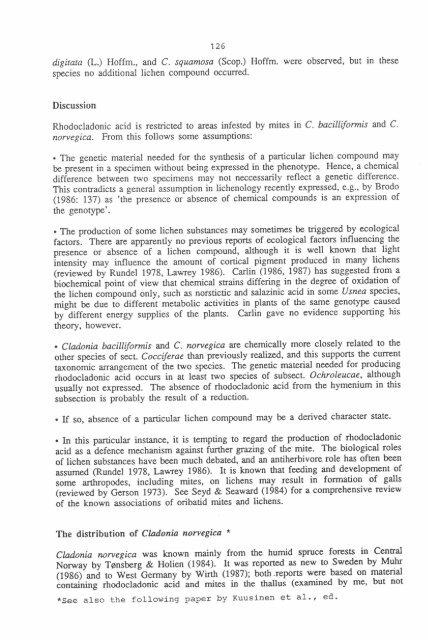-ry wL - Universitetet i Oslo
-ry wL - Universitetet i Oslo
-ry wL - Universitetet i Oslo
You also want an ePaper? Increase the reach of your titles
YUMPU automatically turns print PDFs into web optimized ePapers that Google loves.
126<br />
digitata (L.) Hoffm., ffid C. squamosa (Scop.) Hoffm. were observed, but in these<br />
species no additional lichen compound occurred.<br />
Discussion<br />
Rhodocladonic acid is restricted to areas infested by mites in C. bacilliformis and C.<br />
nomegica. From this follows some assumptions:<br />
. The genetic material needed for the synthesis of a particular lichen compound may<br />
Ue presint in a specimen without being expressed in the phen_otype. Hence, a.chemical<br />
difference between two specimens may not neccessarily rcflect a genetic difference.<br />
This contradics a general assumption in lichenology rccently explessed, e.g., by Brodo<br />
(1986: 137) as 'th-e presence oiabsence of chemical compounds is an expression of<br />
the genotype'.<br />
. The production of some lichen substances may sometimes be qiggereq by ecological<br />
facton- There are apparently no previous reports of ecological factors influencing the<br />
presence or absence'of a iictreri compound., although it is well.known that light<br />
intensity may influence the amount of cortical pigment g_odlced in many lichens<br />
Geview'ed by Rundel l9?8, Lawrcy 1986). Carlil-(1986, 1987) has suggested from a<br />
Uio"tr"-i""Lpoint of view that ctrimicat strains differing in the.degree of oxidation of<br />
fhe tichen co'mpound only, such as norstictic and salazinic acid in some Uszea species,<br />
might be due io differerit metabolic activities in plants of the same genoqrpe caused<br />
Ui?ffo*t energy supplies of the plans. Carlin gave no evidence supporting his<br />
theo<strong>ry</strong>, however.<br />
. Ctadonia bacilliformis and C. rurttegrica are chemically more closely relate/ to the<br />
other species of sect. Cocciferae than previously realizcd, and this suPports the current<br />
U*ono-i" arrangement of rhe nvo species. The genetic material necded for producing<br />
rhodocladonic aIiC occun in at least two species of subsecl Ochroleucae' although<br />
utoUfy not expressed. The absence of rhodocladonic acid from the hymenium in this<br />
subsection is probably the result of a rpduction.<br />
. If so, absence of a particulal lichen compound may be a derived chafacter state'<br />
. In this particular instance, it is temp'$ng to regard the production of rhodocladonic<br />
acid as a iefence mechanism against furttrer grazing of the mite. The biological roles<br />
oflichen substances have been-much debated, and an antiherbivore.role has often been<br />
assumed @undel 1978, Lawrey 1986). It is.known that feeding and development -of<br />
some artt[opodes, including -mites, on lichens , may_ result in formation of e3{s<br />
(reviewed by Genon 1973). See Seyd & seaward (1984) for a comPrehensrve revrew<br />
of the known associations of oribatid mitcs and lichens.<br />
The distribution of Cladonia norvegica *<br />
Ctdonia nontegica was known mainly from the humid spruce forests in 'Cenral<br />
No"""t by Tgniberg & Holien (1934).- It was reported as new to.Sweden by Muhr<br />
ifSSOi'-d to West-Germany by Wirth (1987I bo$ 1eporu *9t" pTd on material<br />
;;;*1ff"id tl"dociaaonic oiA ina mites in the thallui (examined by me, but not<br />
*See also the following PaPer by Kuusinen et a1' ' ed'

















